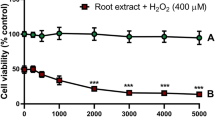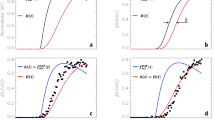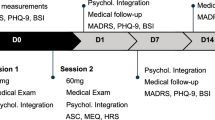Abstract
Unipolar and bipolar depressions show abnormal behavioral manifestations of ultradian (less than 24 h) rhythms, but abnormal rhythms of the central neurotransmitters thought to be important for depression pathophysiology (eg dopamine (DA) and serotonin (5-HT)) have not been shown in this time frame. Since antidepressant treatments normalize disrupted rhythms in depression (eg rapid-eye-movement sleep and hormonal rhythms), we hypothesized that depression-related changes in ultradian oscillations of DA and 5-HT might be revealed during antidepressant treatment. Cerebrospinal fluid (CSF) samples collected q10 min for 24 h in 13 patients experiencing major depressive episodes (MDE) before and after treatment for 5 weeks with sertraline or bupropion were assayed for levels of homovanillic acid (HVA) and 5-hydroxyindoleacetic acid (5-HIAA), and their ratio was calculated. Data were analyzed in the frequency domain using Fourier transforms and multivariate permutation testing. Antidepressant treatments were associated with decreased variance for 5-HIAA, increased variance for HVA, and markedly increased variance for the HVA : 5-HIAA ratio (p<0.05, p<0.02, and p<0.003, respectively). With treatment, the correlations between 5-HIAA and HVA weakened (p=0.06). Power spectral density (PSD—the Fourier magnitude squared) of the 5-HIAA signals at periods of 1.75 and 3.7 h (both p<0.05) decreased, while circadian cycling of HVA levels (p<0.05) and of the ratio (p<0.005) increased after treatment. The PSD of the full-length HVA : 5-HIAA ratio series after treatment increased in rapid variability (20–103 min periods, p<0.05). Spectrographic windowing demonstrated a focal span of enhanced HVA : 5-HIAA ratio variability following antidepressant treatment, in an approximately 84-min period through the evening (p<0.05). Periodic neurotransmitter relationships in depressed patients were altered by treatment in this analysis of a small data set. This may represent a baseline abnormality in the regulation of periodic functions involved in the depression pathophysiology, but it could also be due to an unrelated antidepressant effect. Further studies including comparisons with healthy subject data are in progress.
Similar content being viewed by others
Log in or create a free account to read this content
Gain free access to this article, as well as selected content from this journal and more on nature.com
or
References
Agren H, Koulu M, Saavedra JM, Potter WZ, Linnoila M (1986). Circadian covariation of norepinephrine and serotonin in the locus coeruleus and dorsal raphe nucleus in the rat. Brain Res 397: 353–358.
Akin D, Manier DH, Sanders-Bush E, Shelton RC (2004). Decreased serotonin 5-HT2A receptor-stimulated phosphoinositide signaling in fibroblasts from melancholic depressed patients. Neuropsychopharmacology 29: 2081–2087.
American Psychiatric Association Diagnostic and Statistical Manual of Mental Disorders, 4th edn. APA: Washington, DC; 1994.
Armitage R, Emslie GJ, Hoffmann RF, Weinberg WA, Kowatch RA, Rintelmann J et al (2000). Ultradian rhythms and temporal coherence in sleep EEG in depressed children and adolescents. Biol Psychiatry 47: 338–350.
Armitage R, Hoffman RF, Rush AJ (1999). Biological rhythm disturbance in depression: temporal coherence of ultradian sleep EEG rhythms. Psychol Med 29: 1435–1448.
Bennington JH (1999). Why we believe what we believe about REM-sleep regulation. In: Mallick BN, Inoue S (eds). Rapid Eye Movement Sleep. Narosa Publishing House: New Delhi, India. pp 393–401 quoting Lewis S (1974): The paradoxical sleep cycle revisited. In: Chronobiology Igaku Shoin: Tokyo. pp 487–490.
Birkmayer W, Linauer W (1970). Störung des Tyrosin- und Tryptophan- metabolismus bei Depression. Arch Psychiat Nervenkr 213: 377–387.
Blackford J (2002). Multivariate Permutation Testing for Paired t-Tests (computer program), Version 1.2. Vanderbilt Kennedy Center for Research in Human Development: Nashville, TN. (Requires R Project statistical software.).
Blair RC, Karniski W (1994). Distribution-free statistical analyses of surface and volumetric maps. In: Thatcher RW, Hallet M, Zeffiro T, John ER, Huerta M (eds). Functional Neuroimaging: Technical Foundations. Academic Press: San Diego.
Blier P, Galzin AM, Langer SZ (1989). Diurnal variation in the function of serotonin terminals in the rat hypothalamus. J Neurochem 52: 453–459.
Bunney WE, Bunney BG (2000). Molecular clock genes in man and lower animals: possible implications for circadian abnormalities in depression. Neuropsychopharmacology 22: 335–345.
Carpenter LL, Kupfer DJ, Frank E (1986). Is diurnal variation a meaningful symptom in unipolar depression? J Affect Disord 11: 255–264.
Carpenter LL, Moreno FA, Kling MA, Anderson GM, Regenold WT, Labiner DM et al (2004). Effect of vagus nerve stimulation on cerebrospinal fluid monoamine metabolites, norepinephrine, and gamma-aminobutyric acid concentrations in depressed patients. Biol Psychiatry 56: 418–426.
Cassano P, Fava M (2004). Tolerability issues during long-term treatment with antidepressants. Ann Clin Psychiatry 16: 15–25.
Cazard P, Ricard F, Facchetti L (1992). Depression and functional EEG asymmetry. Ann Med Psychol (Paris) 150: 230–239.
Chergui K, Svenningsson P, Greengard P (2004). Cyclin-dependent kinase 5 regulates dopaminergic and glutamatergic transmission in the striatum. Proc Natl Acad Sci USA 101: 2191–2196 Epub 2004 Feb 09.
Cohen J (1992). A power primer. Psychol Bull 112: 155–159.
DeBellis MD, Geracioti Jr TD, Altemus M, Kling MA (1993). Cerebrospinal fluid monoamine metabolites in fluoxetine-treated patients with major depression and in healthy volunteers. Biol Psychiatry 33: 636–641.
Duncan Jr WC (1986). Circadian rhythms and the pharmacology of affective illness. Pharmacol Ther 71: 243–312.
Duncan Jr WC, Johnson KA, Sutin E, Wehr TA (1998). Disruption of the activity–rest cycle by MAOI treatment: dependence on light and a secondary visual pathway to the circadian pacemaker. Brain Res Bull 45: 457–465.
Ehlers CL, Frank E, Kupfer DJ (1988). Social zeitgebers and biological rhythms. A unified approach to understanding the etiology of depression. Arch Gen Psychiatry 45: 948–952.
Ehlers CL, Kupfer DJ (1987). Hypothalamic peptide modulation of EEG sleep in depression: a further application of the S-process hypothesis. Biol Psychiatry 22: 513–517.
Engstrom G, Alling C, Blennow K, Regnell G, Traskman-Bendz L (1999). Reduced cerebrospinal HVA concentrations and HVA/5-HIAA ratios in suicide attempters. Monoamine metabolites in 120 suicide attempters and 47 controls. Eur Neuropsychopharmacol 5: 399–405.
Eriksson E, Alling C, Andersch B, Andersson K, Berggren U (1994). Cerebrospinal fluid levels of monoamine metabolites. A preliminary study of their relation to menstrual cycle phase, sex steroids, and pituitary hormones in healthy women and in women with premenstrual syndrome. Neuropsychopharmacology 11: 201–213.
Fabre V, Boutrel B, Hanoun N, Lanfumey L, Fattaccini CM, Demeneix B et al (2000). Homeostatic regulation of serotonergic function by the serotonin transporter as revealed by nonviral gene transfer. J Neurosci 20: 5065–5075.
First MB, Spitzer RL, Gibbon M, Williams JBW (1996a). Structured Clinical Interview for DSM-IV Axis I Disorders (SCID-I/P), (Version 20). Biometrics Research Department, New York State Psychiatric Institute, 722 West 168th Street: NY 10032, USA.
First MB, Spitzer RL, Gibbon M, Williams JBW, Benjamin L (1996b). Structured Clinical Interview for DSM-IV Axis II Personality Disorders (SCID-II), (Version 20) Biometrics Research Department, New York State Psychiatric Institute, 722 West 168th Street: NY 10032, USA.
Geracioti Jr TD, Keck Jr PE, Ekhator NN, West SA, Baker DG, Hill KK et al (1998). Continuous covariability of dopamine and serotonin metabolites in human cerebrospinal fluid. Biol Psychiatry 44: 228–233.
Geracioti Jr TD, Loosen PT, Ekhator NN, Schmidt D, Chambliss B, Baker DG et al (1997). Uncoupling of serotonergic and noradrenergic systems in depression: preliminary evidence from continuous cerebrospinal fluid sampling. Depress Anxiety 6: 89–94.
Geracioti Jr TD, Orth DN, Ekhator NN, Blumenkopf B, Loosen PT (1992). Serial cerebrospinal fluid corticotropin-releasing hormone concentrations in healthy and depressed humans. J Clin Endocrinol Metab 74: 1325–1330.
Grunebaum MF, Galfalvy HC, Oquendo MA, Burke AK, Mann JJ (2004). Melancholia and the probability and lethality of suicide attempts. Br J Psychiatry 184: 534–535.
Harmer CJ, Shelley NC, Cowen PJ, Goodwin GM (2004). Increased positive versus negative affective perception and memory in healthy volunteers following selective serotonin and norepinephrine reuptake inhibition. Am J Psychiatry 161: 1256–1263.
Haug H-J, Wirz-Justice A (1993). Diurnal variation of mood in depression: important or irrelevant? Biol Psychiatry 34: 201–203.
Hayashi M, Sato K, Hori T (1994). Ultradian rhythms in task performance, self-evaluation, and EEG activity. Percept Mot Skills 79: 791–800.
Healy D (1987). Rhythm and blues. Neurochemical, neuropharmacological and neuropsychological implications of a hypothesis of circadian rhythm dysfunction in the affective disorders. Psychopharmacology (Berl) 93: 271–285.
Hill KK, West SA, Ekhator NN, Bruce AB, Wortman MD, Baker DG et al (1999). The effect of lumbar puncture stress on dopamine and serotonin metabolites in human cerebrospinal fluid. Neurosci Lett 276: 25–28.
Hobson JA, McCarley RW, Wyzinski PW (1975). Sleep cycle oscillation: reciprocal discharge by two brainstem neuronal groups. Science 189: 55–58.
Holmes MC, French KL, Seckl JR (1997). Dysregulation of diurnal rhythms of serotonin 5-HT2C and corticosteroid receptor gene expression in the hippocampus with food restriction and glucocorticoids. J Neurosci 17: 4056–4065.
Jouvent R, Le Houezec J, Payan C, Mikkelsen H, Fermanian J, Millet V et al (1998). Dimensional assessment of onset of action of antidepressants: a comparative study of moclobemide vs clomipramine in depressed patients with blunted affect and psychomotor retardation. Psychiatry Res 79: 267–275.
Kennedy JS, Gwirtsman HE, Schmidt DE, Johnson BW, Fielstein E, Salomon RM et al (2002). Serial cerebrospinal fluid tryptophan and 5-hydroxy indoleacetic acid concentrations in healthy human subjects. Life Sci 71: 1703–1715.
Klein R, Armitage R (1979). Rhythms in human performance: 1 1/2-hour oscillations in cognitive style. Science 204: 1326–1328.
Kleitman N (1982). Basic rest–activity cycle—22 years later. Sleep 5: 311–317.
Knapp S, Mandell AJ (1983). Lithium and chlorimipramine differentially alter the stability properties of tryptophan hydroxylase as seen in allosteric and scattering kinetics. Psychiatry Res 8: 311–323.
Knott VJ, Telner JI, Lapierre YD, Browne M, Horn ER (1996). Quantitative EEG in the prediction of antidepressant response to imipramine. J Affect Disord 39: 175–184.
Kraepelin E (1913). Klinische Psychiatrie. Ein Lehrbuch für Studierende und Ärzte. III. Be., II. Teil. Verlag J.A. Barht, Leipzig.
Kulikov A, Mormede P, Chaouloff F (1997). Effects of adrenalectomy and corticosterone replacement on diurnal [3H]-citalopram binding in the rat midbrain. Neurosci Let 222: 127–131.
Lovenberg TW, Baron BM, de Lecea L, Miller JD, Prosser RA, Rea MA et al (1993). A novel adenylyl cyclase-activating serotonin receptor (5-HT7) implicated in the regulation of mammalian circadian rhythms. Neuron 11: 449–458.
Mazure C, Nelson JC, Price LH (1986). Reliability and validity of the symptoms of major depressive illness. Arch Gen Psychiatry 43: 451–456.
McCarley RW, Massaquoi SG (1986). A limit cycle mathematical model of the REM sleep oscillator system. Am J Physiol Regul Integr Comp Physiol 251: R1011–R1029.
Mullins UL, Gianutsos G, Eison AS (1999). Effects of antidepressants on 5-HT7 receptor regulation in the rat hypothalamus. Neuropsychopharmacology 21: 352–367.
Nakayama K (2002). Diurnal rhythm in extracellular levels of 5-hydroxyindoleacetic acid in the medial prefrontal cortex of freely moving rats: an in vivo microdialysis study. Prog Neuropsyhopharmacol Biol Psychiatry 26: 1383–1388.
Nishi M, Kawata M, Azmitia EC (2000). Trophic interactions between brain-derived neurotrophic factor and s100beta on cultured serotonergic neurons. Brain Res 868: 113–118.
Oxenkrug GF (1979). The content and uptake of 5-HT by blood platelets in depressive patients. J Neural Transm 45: 285–289.
Pezard L, Nandrino JL, Renault B, el Massioui F, Allilaire JF, Muller J et al (1996). Depression as a dynamical disease. Biol Psychiatry 39: 991–999.
Polich J (1997). On the relationship between EEG and P300: individual differences, aging, and ultradian rhythms. Int J Psychophysiol 26: 299–317.
Prospero-Garcia O, Navarro L, Murillo-Rodriguez E, Sanchez-Alvarez M, Guzman-Marin R, Mendez-Diaz M et al (1999). Cellular and molecular changes occurring during REM sleep. In: Mallick BN, Inoue S (eds). Rapid Eye Movement Sleep. Narosa Publishing House: New Delhi, India. pp 367–381.
R: Copyright 2003. The R Foundation for Statistical Computing. Version 1.8.1 (2003-11-21), ISBN 3-900051-00-3.
Raghunathan TE, Rosenthal R, Rubin DB (1996). Comparing correlated but nonoverlapping correlations. Psychol Methods 1: 178–183.
Rao ML, Groww G, Strebel B, Halaris A, Huber G, Bräunig P et al (1994). Circadian rhythm of tryptophan, serotonin, melatonin, and pituitary hormones in schizophrenia. Biol Psychiatry 35: 151–163.
Raoux N, Benoit O, Dantchev N, Denise P, Franc B, Allilaire JF et al (1994). Circadian pattern of motor activity in major depressed patients undergoing antidepressant therapy: relationship between actigraphic measures and clinical course. Psychiatry Res 52: 85–98.
Riederer P, Birkmayer W, Neumayer E, Ambrozi L, Linauer W (1974). The daily rhythm of HVA, VMA, (VA) and 5-HIAA in depression-syndrome. J Neural Transm 35: 23–45.
Risby ED, Hsiao JK, Sunderland T, Agren H, Rudorfer MV, Potter WZ (1987). The effects of antidepressants on the cerebrospinal fluid homovanillic acid/5-hydroxyindoleacetic acid ratio. Clin Pharmacol Ther 42: 547–554.
Rogers MA, Bellgrove MA, Chiu E, Mileshkin C, Bradshaw JL (2004). Response selection deficits in melancholic but not nonmelancholic unipolar major depression. J Clin Exp Neuropsychol 26: 169–179.
Salomon RM, Ripley B, Kennedy JS, Johnson B, Schmidt D, Zeitzer JM et al (2003). Diurnal variation of cerebrospinal fluid hypocretin-1 (Orexin-A) levels in control and depressed subjects. Biol Psychiatry 54: 96–104.
Schildkraut JJ (1965). The catecholamine hypothesis of affective disorders: a review of supporting evidence. Am J Psychiatry 122: 509–522.
Schmidt DE, Roznoski ML, Ebert MH (1990). Qualitative and quantitative HPLC analysis of monoamine neurotransmitters and metabolites in CSF and brain tissue using reductive electrochemical detection. Biomed Chromotogr 4: 215.
Shannahoff-Khalsa D (1993). The ultradian rhythm of alternating cerebral hemispheric activity. Int J Neurosci 70: 285–298.
Thase ME, Fasiczka AL, Berman SR, Simons AD, Reynolds III CF (1998). Electroencephalographic sleep profiles before and after cognitive behavior therapy of depression. Arch Gen Psychiatry 55: 138–144.
Tran PV, Bymaster FP, McNamara RK, Potter WZ (2003). Dual monoamine modulation for improved treatment of major depressive disorder. J Clin Psychopharmacol 23: 78–86.
Trivedi MH, Rush AJ, Crismon ML, Kashner TM, Toprac MG, Carmody TJ et al (2004). Clinical results for patients with major depressive disorder in the Texas Medication Algorithm Project. Arch Gen Psychiatry 61: 669–680.
Van Reeth O, Olivares E, Zhang Y, Tripathi B, Turek FW (1999). Chronobiotic effects of gepirone, a potential antidepressant with 5HT1A receptor partial agonist properties. Behav Pharmacol 10: 119–130.
Wefelmeyer T, Kuhs H (1996). Diurnal mood variation in melancholic patients and healthy controls. Psychopathology 29: 184–192.
Wehr TA, Muscettola G, Goodwin FK (1980). Urinary 3-methoxy-4-hydroxyphenylglycol circadian rhythm. Early timing (phase-advance) in manic-depressives compared with normal subjects. Arch Gen Psychiatry 37: 257–263.
Wehr TA, Wirz-Justice A, Goodwin FK, Duncan W, Gillin JC (1979). Phase advance of the circadian sleep–wake cycle as an antidepressant. Science 206: 710–713.
Wirz-Justice A (2000). Biological rhythms in mood disorders. In: FE Bloom and DE Kupfer (eds). Neuropsychopharmacology: the Fourth Generation of Progress http://www.acnp.org/g4/GN401000099/Default.htm accessed 1/9/05.
Acknowledgements
We are particularly grateful to all of the subjects and GCRC staff, and for helpful discussions and support from Richard Shelton, MD, and Ariel Deutch, PhD among many others. This work was funded by grant support to RMS (K23 MH01828 from NIMH, the Stanley Foundation, NARSAD, and an investigator-initiated grant from Pfizer, Inc.), to the Vanderbilt General Clinical Research Center (M01 RR00095 from NICCR), and to the Vanderbilt Kennedy Center for Research on Human Development (supporting JUB, grant P30 HD15052 from NICHD). Presented, in part, in meeting abstracts: the American Psychiatric Association, Toronto May 1998, and the American College of Neuropsychopharmacology, Puerto Rico December 1998 and December 2003.
Author information
Authors and Affiliations
Corresponding author
Additional information
Supplementary Information accompanies the paper on Neuropsychopharmacology website (http://www.nature.com/npp)
Supplementary information
Rights and permissions
About this article
Cite this article
Salomon, R., Kennedy, J., Johnson, B. et al. Treatment Enhances Ultradian Rhythms of CSF Monoamine Metabolites in Patients with Major Depressive Episodes. Neuropsychopharmacol 30, 2082–2091 (2005). https://doi.org/10.1038/sj.npp.1300746
Received:
Revised:
Accepted:
Published:
Issue date:
DOI: https://doi.org/10.1038/sj.npp.1300746



